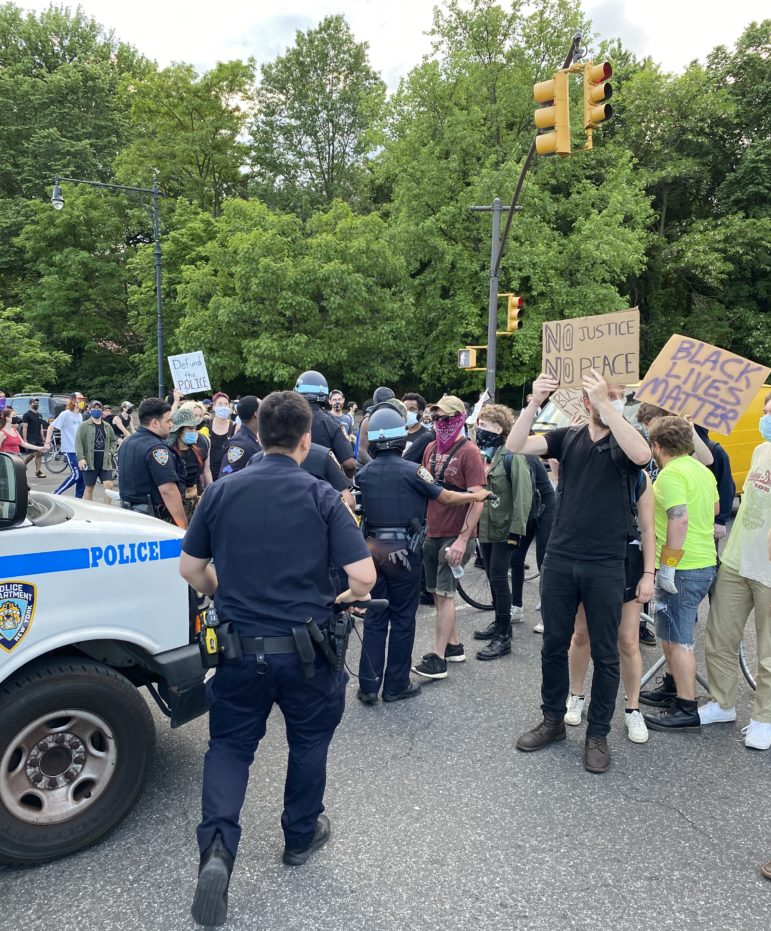
Parker Quinlan
Protestors and police standoff in the middle of the street next to Prospect Park in Brooklyn on May 30.
NEW YORK — After weeks of protest across New York, state and local elected officials are still scrambling to develop plans to divert funding from police departments, and deciding to reallocate the funds toward youth-based social services.
On Friday, Gov. Andrew Cuomo signed an executive order stating funding will be withheld if any local police department — including the New York Police Department — does not implement plans that reinvent and modernize police strategies and programs based on community input, the statement said.
In a joint statement released late Friday afternoon, New York City Council leaders, including the co-chairs of the Black, Latino, and Asian Caucus and Speaker Corey Johnson, announced their intentions to “cut over $1 billion dollars, including reducing uniform headcount through attrition, cutting overtime, shifting responsibilities away from the NYPD, finding efficiencies and savings in OTPS [Other Than Personal Service, or nonsalary] spending, and lowering associated fringe expenses.”

Johnson had indicated his willingness to support reforms earlier in the week, and expressed frustration that initial budget cuts forced by coronavirus were not sufficient.
“As we have said, a less than one percent cut to the NYPD and a 32% cut to Department of Youth and Community Development is not representative of our values and the City Council will not approve a budget that fails to significantly reduce the NYPD budget and start us on a path to bringing structural change and transformational reforms to the police department,” a statement from Johnson’s office said Wednesday.
Reallocating the funding is expected to produce a raucous debate among city officials, no matter how much money is taken from the department, with no clear sense of where the money should go.
In a statement, the president of the Police Benevolent Association (PBA) predicted that if the city moved forward with its plan to cut funding, crime could increase as a result.
“For decades, every time a city agency failed at its task, the city’s answer was to take the job away and give it to the NYPD. If the City Council wants to give responsibilities back to those failing agencies, that’s their choice. But they will bear the blame for every new victim, for every New Yorker in need of help who falls through the cracks. They won’t be able to throw cops under the bus anymore,” said PBA President Pat Lynch.
De Blasio opposes $1 billion cut
Last week, Mayor Bill de Blasio announced plans to strip funding from the NYPD, though there were no details on how much money should be taken or where it should be reinvested.
On Friday, after city council leaders announced their plans to remove over a billion dollars in funding from the NYPD, the mayor’s office suggested that the cuts were misguided.
“The mayor has said we’re committed to reprioritizing funding and looking for savings, but he does not believe a $1 billion cut is the way to maintain safety,” Freddi Goldstein, the mayor’s press secretary, said in a statement.
The mayor’s plan, or lack thereof, comes as cities across the state try to reconcile their police budgets with the growing calls for defunding law enforcement, without a clear consensus from activists on how much funding can be removed without sacrificing public safety.
Scott Stringer, the city’s comptroller, recommended in a June 4 letter to the mayor that $1.1 billion be transferred from the $5.7 billion NYPD budget over the next four years.
“Redirecting funds toward trained social workers, counselors, and outreach staff to help them respond to challenges like homelessness and mental health disorders — which are circumstances rooted in poverty, trauma, and structural racism, not crimes in progress — would produce far more positive outcomes,” he wrote.
Stringer suggested a hiring freeze of officers over the next year. Reductions in the NYPD’s spending on computer services and other service contracts, as well as lengthening the replacement cycle for NYPD vehicles, would further reduce the budget.
In the mayor’s proposed budget for next year, the NYPD has been allocated over $519 million for overtime spending. By cutting this allocation by 5%, Stringer says the city would save $26 million annually.
All these cuts in the Stringer plan would save the city $265 million over four years, a drop in the bucket of the massive city budget, which is $101.5 billion this year.
Full reorganization called for
Brooklyn Councilman Antonio Reynoso agreed that funds need to be directed toward programs that support communities that in many instances have had funds withheld for years due to structural racism.
“So much of police activity is focused on crimes that stem directly from poverty and a lack of mental health resources and the council member believes we need to address these root issues, rather than criminalizing them,” said Asher Freeman, a spokesperson for Reynoso.
While Freeman said that they do not know where other council members stand on the topic, Reynoso is calling for the NYPD to be fully reorganized. Issues are rooted in the department’s culture, which cannot be changed by training, Reynoso said.
Local officials in upstate New York are now struggling to quickly comply with Cuomo’s executive order, while also balancing their commitments to their police departments.
Unlike New York City, two local governments upstate have expressed skepticism about cutting police funding to reinvest in youth services.
In Endicott, a village three hours northwest of New York City, Mayor Linda Jackson is a proud supporter of her town police and said budget cuts could hurt her otherwise quiet town.
“When you say we don’t want to have as many policemen, well, then you figure they’re the ones that are going to defend us, and only the rich are going to have bodyguards, like the politicians. I think this is more of a political problem, than a racial problem,” she said.
While Jackson said she wants to support police, she remains supportive of the protestors as well, saying she is “totally behind” their rights to protest.
Just under 10 miles east of Endicott, Binghamton is also trying to balance between initiating reforms while preserving its relationship with police.
Binghamton Mayor Rich David has added back officer positions cut by previous administrations and spent $1.2 million renovating the police department’s headquarters. The department’s recently released use of force policy bans chokeholds, neck restraints and shooting at moving vehicles.
Binghamton Police Chief Joseph Zikuski said in the near future the document will also state the duty of officers to intervene, which requires one officer to stop or prevent a fellow officer from using excessive force.
He offered to make lesson plans and training material public, providing transparency about how police are instructed on internal accountability. He maintains that officers are adequately trained on how to detect misuse of force by others in the department.
Some local officials like Jackson believe police can continue to fill roles such as drug enforcement, and that their funding does not need to be shifted to social workers.
Jackson suggested that her chief of police, Patrick Garey, who has a background in state drug enforcement, is capable of more than just making arrests.
“He’s very enlightened when it comes to not only diversity but drugs as well,” Jackson said.
Gabe Stern contributed to this story.































